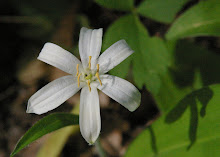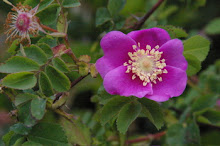I have used several things to help me with the identification process of the desert wildflowers. I picked up two pamphlets in the ranger stations that really helped me.
Wildflowers of Death Valley National Park, put out by the Death Valley Natural History Association. $2.50.
Wildflowers of Joshua Tree National Park, produced by the Joshua Tree National Park Association, in cooperation with the National Park Service. $1.50.
On the web, I've found two very helpful websites.
Desertusa.com has a very helpful online field guide to desert wildflowers which allows you to search by color, or download an mp3 to take with you on a hike.
Black Turtle has made a fantastic website of Death Valley Area Wildflowers. You can search by common names, scientific names or colors.
And if you need some of those wildflowers growing in your yard, Plants of the Southwest can help you. I found they sell wildflower seeds. Now if I could just choose which ones I want to order.
Now, lets take a look at some of the lovelies I found. I've got wildflowers, cactus, Joshua Trees, Mountains and a nesting Red Tailed Hawk for you.
 Mojave National Preserve isn't all flat. It has Joshua trees, cinder cones and desert tortoise. We would have loved to search out a tortoise, but will have to save that for another time. We only had enough time to drive through the park, stop at the visitor's center and pull over for new wildflowers or interesting vistas.
Mojave National Preserve isn't all flat. It has Joshua trees, cinder cones and desert tortoise. We would have loved to search out a tortoise, but will have to save that for another time. We only had enough time to drive through the park, stop at the visitor's center and pull over for new wildflowers or interesting vistas. The views were interesting, but if you didn't watch your step, it was likely that you would step on fresh bloom. Tiny little Woolly Daisies, and purple mat carpeted many places.
The views were interesting, but if you didn't watch your step, it was likely that you would step on fresh bloom. Tiny little Woolly Daisies, and purple mat carpeted many places. Woolly Daisy (Eriophyllum wallacei) grow only a few inches high, but are as cute as a little yellow button.
Woolly Daisy (Eriophyllum wallacei) grow only a few inches high, but are as cute as a little yellow button. Spanish Needles (Palafoxia linea) are lovely close up.
Spanish Needles (Palafoxia linea) are lovely close up.
 The pink flowers in the above picture is the very fragrant Sand Verbena (Abronia villosa).
The pink flowers in the above picture is the very fragrant Sand Verbena (Abronia villosa). The white flowers from the above pictures (and on the top of this page) are the lovely, large flowered Dune Evening-Primrose (Oenothera deltoides).
The white flowers from the above pictures (and on the top of this page) are the lovely, large flowered Dune Evening-Primrose (Oenothera deltoides).  Joshua Trees (Yucca brevifolia) are quite interesting. They grow really slow, and aren't very strong. They are pollinated by the Yucca moth. They grow either from seed or from an underground rhizome from another tree. If it survives desert life, it can live a couple hundred years, but it doesn't grow with annual growth rings, so it is difficult to tell how old they are. To bloom they must have a winter freeze, and enough rainfall. They don't start branching until after they have bloomed.
Joshua Trees (Yucca brevifolia) are quite interesting. They grow really slow, and aren't very strong. They are pollinated by the Yucca moth. They grow either from seed or from an underground rhizome from another tree. If it survives desert life, it can live a couple hundred years, but it doesn't grow with annual growth rings, so it is difficult to tell how old they are. To bloom they must have a winter freeze, and enough rainfall. They don't start branching until after they have bloomed. In the distance of this photo you can see the famous Kelso Dunes. They know for the sound they make as you slide down the dunes. The low frequency rumble is called "booming dunes."
In the distance of this photo you can see the famous Kelso Dunes. They know for the sound they make as you slide down the dunes. The low frequency rumble is called "booming dunes."  The blue flower in the foreground is Blue Phacelia (Phacelia distans). After some searching around I have decided that the unidentified blue flower on my first Death Valley wildflower page is also likely the Blue Phacelia or one closely related.
The blue flower in the foreground is Blue Phacelia (Phacelia distans). After some searching around I have decided that the unidentified blue flower on my first Death Valley wildflower page is also likely the Blue Phacelia or one closely related. Broad-Flowered Gila (Gilia latiflora)
Broad-Flowered Gila (Gilia latiflora) Red Tailed Hawk sitting her nest in a Joshua Tree, several miles north of Kelso Visitor's Center.
Red Tailed Hawk sitting her nest in a Joshua Tree, several miles north of Kelso Visitor's Center.
After the hawk took off flying, I found these Fremont Phacelia (Phacelia fremontii) blooming nearby.

Close up the Fremont Phacelia reminds me of a petunia, but the flowers are smaller then a dime in size.

Desert Gold or Desert Sunflower (Geraea canescens)
 Desert Gold Poppy (Eschscholzia glyptosperma). Golden yellow flowers that I thought at first were pale California Poppies. I was surprised to learn that there is more then one kind of gold colored poppy. The famous California Poppy has bigger flowers and their color is more toward an orange.
Desert Gold Poppy (Eschscholzia glyptosperma). Golden yellow flowers that I thought at first were pale California Poppies. I was surprised to learn that there is more then one kind of gold colored poppy. The famous California Poppy has bigger flowers and their color is more toward an orange. Globe Mallow or Desert Mallow (Sphaeralcea ambigua)
Globe Mallow or Desert Mallow (Sphaeralcea ambigua) The fuzzy leaves can irritate the skin of some people. As the plant increases in age, so do the number of it's branches.
The fuzzy leaves can irritate the skin of some people. As the plant increases in age, so do the number of it's branches. Desert Star (Monoptilon bellioides)
Desert Star (Monoptilon bellioides) Arizona Lupine (Lupinus arizonicus)
Arizona Lupine (Lupinus arizonicus) Beaver Tail Cactus almost ready to bloom. Click on the link if you want to see what the pretty pink blooms look like when they are open.
Beaver Tail Cactus almost ready to bloom. Click on the link if you want to see what the pretty pink blooms look like when they are open. Close to the southern entrance to the park we came upon a most lovely scene with rocks, yucca, cactus and wildflowers. Birds were singing from nearby trees.
Close to the southern entrance to the park we came upon a most lovely scene with rocks, yucca, cactus and wildflowers. Birds were singing from nearby trees. We pulled over and walked around. It was almost like being in a garden. There was short green plants that felt like a lawn after walking on sand on rocks. Granite boulders lay around as if arranged on purpose.
We pulled over and walked around. It was almost like being in a garden. There was short green plants that felt like a lawn after walking on sand on rocks. Granite boulders lay around as if arranged on purpose.
Cholla (pronounce Choy-ya) posed beside the yucca, and thankfully I didn't get caught with their prickly spines.
 We were so glad that we got to visit this lovely place, at such a lovely time of year, and will treasure memories of fun family times for years to come.
We were so glad that we got to visit this lovely place, at such a lovely time of year, and will treasure memories of fun family times for years to come.






5 bouquets of wildflowers (Comment here):
WOW! What a fantastic trip to the blooming desert! I enjoyed every step of it! Great pics.
Jody
I'm more than envious. I did get to visit the desert during the winter and enjoyed it very much. But, the spring blooms call me.
So beautiful!!!!!
Fantastic blog entry, thanks so much for sharing. What a whopper of a Joshua tree in the one photo.
Amazing place huh?
I love it,
Barb-Harmony Art Mom
I had no idea the desert was so beautiful. Who knew all those flowers bloom out there??? not I!!!
Post a Comment